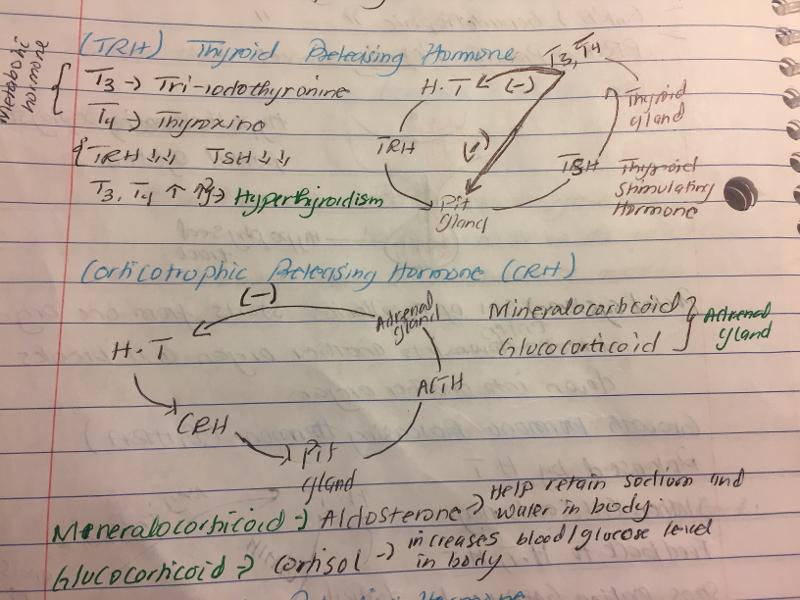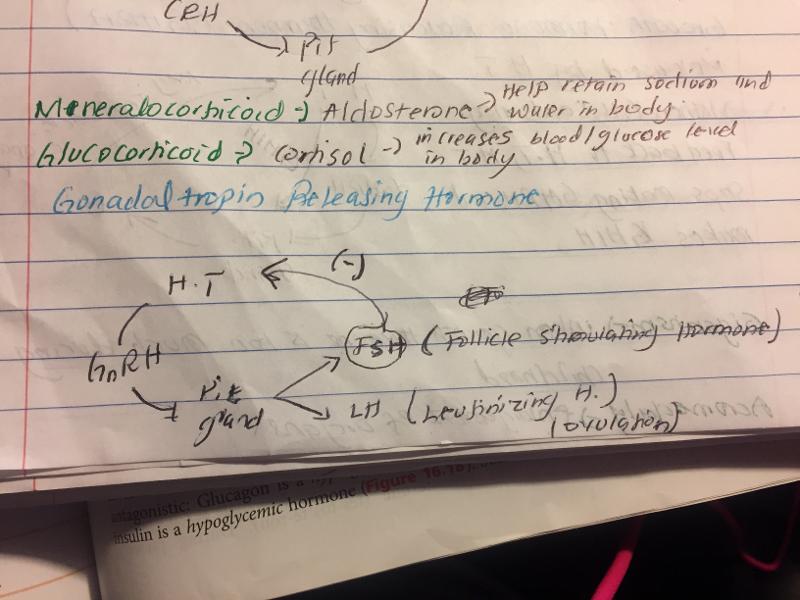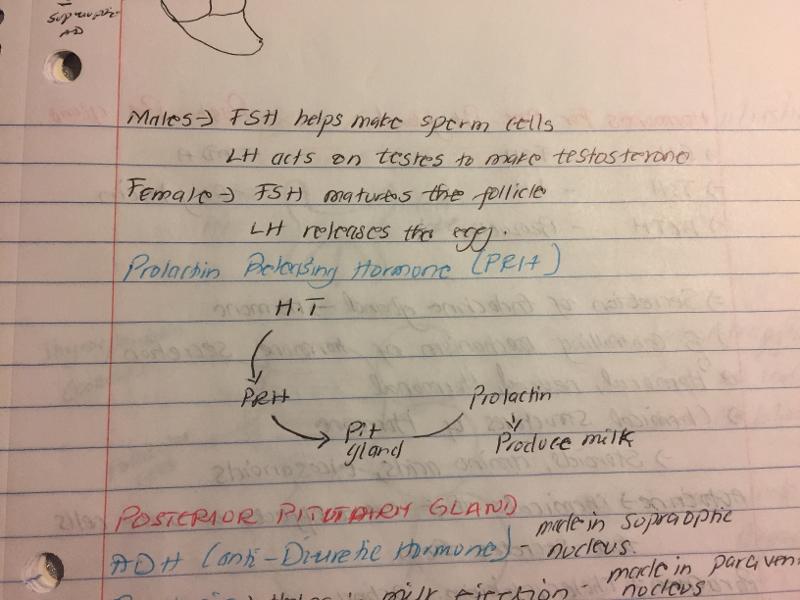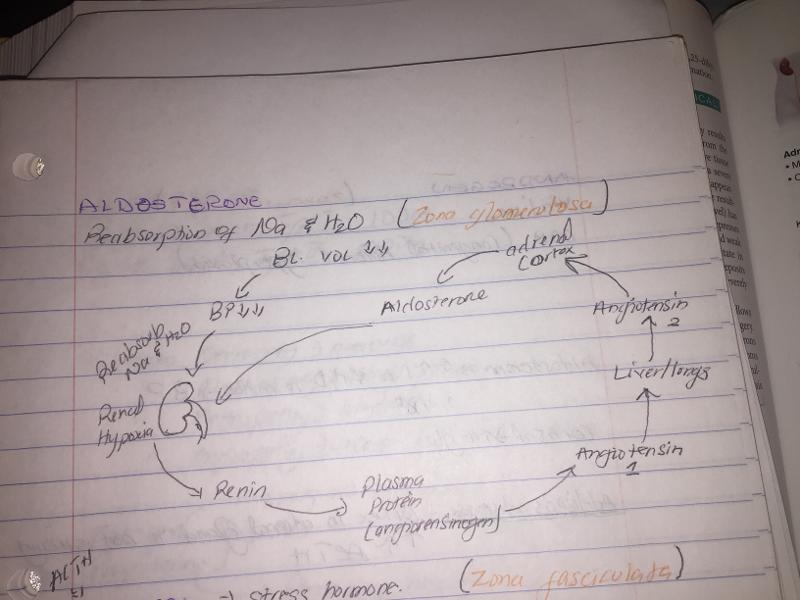Instructions for Side by Side Printing
- Print the notecards
- Fold each page in half along the solid vertical line
- Cut out the notecards by cutting along each horizontal dotted line
- Optional: Glue, tape or staple the ends of each notecard together
Endocrine system
front 1 Classify the types of glands | back 1 Exocrine: produce sweat and saliva, etc. and have ducts Endocrine: produce hormones and are ductless. They release their hormones directly into capillaries to be carried all over the body |
front 2 What is the secretion of endocrine glands called | back 2 hormones |
front 3 List some of the endocrine glands | back 3 Thyroid, parathyroid, pituitary, adrenal, pineal, thymus |
front 4 Chemicals that exerts their effect on the same cells that secrete them are? | back 4 autocrines |
front 5 write the chemical classification of hormones | back 5 amino acid based and steroids |
front 6 List the changes produced by the hormones in the target cells | back 6 -alters plasma membrane permeability or membrane potential by opening or closing ion channels -stimulates synthesis of proteins or enzymes within the cell - activates or deactivates enzymes - induces secretory activity -stimulates mitosis |
front 7 List the mechanism of hormone action | back 7 -cAMP signaling mechanism -PIP- calcium signal mechanism - Steroid hormones-direct gene activation |
front 8 The target cells respond to a hormone only due to the presence of specific | back 8 protein receptors |
front 9 List the factors involved in the activation of hormone receptor complex | back 9 - Blood levels of the hormone - Relative number of receptors for that hormone on or in the target cells - Affinity of the bond between the hormone and the receptor |
front 10 Rising level of specific hormone acting on specific type of cell increases the production of the specific receptors in that cell is the phenomenon as | back 10 up-regulation |
front 11 The concentration of hormone at any time in the blood reflects | back 11 - its rate of release - the speed at which it is inactivated and removed from the body |
front 12 List the ways hormones interact with each other | back 12 - Permissiveness -synergism - antagonism |
front 13 Hormones producing amplified effects when working together on a target cell is what type of hormonal interaction | back 13 synergism |
front 14 What are the three major types of endocrine gland stimuli | back 14 hormonal humoral neural |
front 15 List the hormones released by the anterior pituitary gland | back 15 Growth Hormone thyroid stimulating hormone adrenocorticotropic hormone follicle stimulating hormone Luteinizing hormone Prolactin |
front 16 List the hormones of posterior pituitary gland | back 16 Antidiuretic hormone oxytocin |
front 17 Function of ADH | back 17 made in supraoptic nucleus. prevents urine formation. prevents wide swings in water balance, helping the body avoid dehydration and water balance |
front 18 Function of oxytocin | back 18 released in higher amounts during childbirth and in nursing women acts as a hormonal trigger for milk ejection |
front 19 Function of Growth Hormone (somatrotopin cells) | back 19 increases blood levels of fatty acids decreases rate of glucose uptake and metabolism encourages glycogen breakdown in liver stimulates most body cells to enlarge and divide. |
front 20 Function of thyroid hormone (thyrotropin cells) | back 20 increases basal metabolic rate and body heat production regulates tissue growth and development maintains blood pressure by increasing the number of adrenergic receptors in blood vessels |
front 21 disorders associated with growth hormone | back 21 dwarfism, gigantism, and acromegaly |
front 22 disorders associated with thyroid hormone | back 22 myxedema, goiter, grave's disease |
front 23 Growth hormone releasing hormone | back 23  |
front 24 hypercortisolism | back 24 A syndrome caused by an increased production of ACTH excessive intake of glucocorticoids |
front 25 corticotrophic releasing hormone | back 25  |
front 26 Gonadaltropin releasing hormone (FSH and LH) | back 26  |
front 27 Prolactin releasing hormone | back 27  |
front 28 supraoptic nucleus of hypothalamus release____ hormone, and paraventricular nucleus in hypothalamus secretes____ hormone | back 28 ADH; oxytocin |
front 29 A set of capillaries arising in the hypothalamus forming a vein which enters into the pituitary gland and breaks down into another set of capillaries, this system is called ___ | back 29 hypothalamo-hypophyseal portal system |
front 30 catabolic hormone | back 30 Adrenaline, cortisol, and glucagon |
front 31 anabolic hormone | back 31 stimulate protein synthesis, muscle growth, and insulin. ex. growth hormone, testosterone and estrogen |
front 32 diabetogenic hormone | back 32 ADH deficiency ( diabetes insipidus) insulin dificiency (diabetes mellitus) |
front 33 Marked retention of fluid, edema, weight gain, and hypo-osmolarity of the blood due to excessive secretion of ADH is a syndrome called | back 33 syndrome of inappropriate ADH secretion |
front 34 deficiency of iodine will cause which hormone deficiency condition | back 34 goiter |
front 35 deficiency of thyroxine since birth will cause mental retardation and the condition is called | back 35 cretinism |
front 36 which of the following is not a category of endocrine gland stimulus | back 36 enzyme |
front 37 oxytocin | back 37 is an example of positive feedback control mechanism during labor stimulated by suckling of infant at breast and labor inhibited by lack of appropriate neural stimuli |
front 38 ADH | back 38 is inhibited by alcohol and hydrationn stimulated by pain, some drugs, low blood pressure |
front 39 The ability of a specific tissue or organ to respond to the presence of a hormone is dependent on | back 39 the presence of the appropriate receptors on the cells of the target tissue or organ |
front 40 a patient with normal kidney function test came with polyuria and polydipsia complains and you identified the low urine osmolality and no blood or pus in the urine. The most probable diagnosis is | back 40 pituitary diabetes insipidus |
front 41 Insulin, a small protein, is released in response to | back 41 when the body's glucose level rises |
front 42 insulin, a small protein, is synthesized by | back 42 beta cells of pancreas |
front 43 Hormone that regulates the blood calcium level by enhancing the reabsorption of calcium from the gut, kidney, and bones by increasing the osteoclast activity is | back 43 parathyroid hormone |
front 44 Growth hormones act via | back 44 somatomeidin |
front 45 Which of the following is sometimes used as a second messenger of amino acid-base hormones? | back 45 calcium |
front 46 in the event of prolonged fasting the blood sugar can be maintained by increased release of which of the following hormones causing glycogenolysis from the liver and gluconeogenesis | back 46 glucagon |
front 47 suckling stimulates the release of which hormone that encourages the continued milk production | back 47 prolactin releasing hormone |
front 48 from where is PRH and PIH released | back 48 hypothalamus |
front 49 Which neurotransmitter is now recognized as prolactin and inhibitor | back 49 dopamine |
front 50 The hormone responsible for setting basal metabolic rate is | back 50 thyroid hormones |
front 51 the terminology for posterior pituitary gland is | back 51 neurohypophysis |
front 52 leukotrienes and prostaglandins are classified as | back 52 eicosanoids |
front 53 define half life | back 53 it is the duration from the time of release of a hormone to the time when its concentration is reduce by 50% |
front 54 superior thyroid artery is a branch of internal carotid artery | back 54 false |
front 55 locally acting chemicals that affect cells other than those that secrete them is classified as paracrines | back 55 true |
front 56 eicosanoids, which inhibits the production of blood clots are called prostaglandin PGE2 | back 56 false |
front 57 corticotrophic releasing hormone is released from the hypothalamus | back 57 true |
front 58 one hormone cannot exert its effect without another hormone being present is antagonism | back 58 false |
front 59 superior thyroid artery is a branch of | back 59 external carotid artery |
front 60 Name the structures present in spermatic cord | back 60 nerve fibers, blood vessels, and lymphatic |
front 61 Which of the following statements is applicable to antidiuretic hormone (ADH) | back 61 is released by neurohypophysis |
front 62 Which of the following is true of neurohypophysis | back 62 it is only a hormone storage area that receives hormones from the hypothalamus for release |
front 63 In the event of a high blood sugar level, the increased release of which of the following hormones is anticipated | back 63 glucagon |
front 64 ACTH | back 64 is secreted by corticotropic cells stimulates adrenal cortex to release corticosteroid hormones. its release is elicited by hypothalamic CRH. |
front 65 Which of the following is true about calcium homeostasis | back 65 high calcium levels cause bone resorption |
front 66 Which of the following statement is true for aldosterone | back 66 production is greatly influenced by rennin angiotensin system activation |
front 67 an infant born with ambiguous genitalia is most likely to have which of the following condition in the blood | back 67 high androgen |
front 68 which of the following does not stimulate endocrine glands | back 68 enzyme |
front 69 addison's disease | back 69 over secretion of cortisol increase in ACTH |
front 70 gigantism | back 70 over secretion of hormone from pituitary somatotrophs |
front 71 pheochromocytoma | back 71 hypoadrenalism |
front 72 diabetes insipidus | back 72 deficiency of ADH |
front 73 cushing's disease | back 73 malignant hypertension |
front 74 supraoptic nucleus | back 74 antidiuretic hormone |
front 75 paraventricular nucleus | back 75 oxytocin |
front 76 oral mucosa | back 76 adenohypophysis |
front 77 hypercortisolism | back 77 A syndrome caused by an increased production of ACTH from a tumor of the adrenal cortex or of the anterior lobe of the pituitary gland, or by excessive intake of glucocorticoids |
front 78 diabetes mellitus | back 78 results from either hyposecretion or hypoactivity of insulin |
front 79 type I diabetes mellitus | back 79 absent of insulin |
front 80 type II diabetes mellitus | back 80 insulin is present but effects are deficient |
front 81 hyperadrenalism | back 81 marked by the presence of high cortisol levels in the blood |
front 82 hyperthyroidism | back 82 Grave's disease overactivity of the thyroid gland, resulting in a rapid heartbeat and an increased rate of metabolism |
front 83 hypothyroidism | back 83 cretinism in infants when it is due to iodine deficiency and congenital hypothyroidism when it's due to congenital abnormality of the thyroid gland. |
front 84 hyperparathyroidism | back 84 excessive calcium kidney stones and arteriosclerosis excess PTH |
front 85 hypoparathyroidism | back 85 tripod sign. diminishing concentration of parathyroid hormone in the blood PTH deficiency |
front 86 autocrines | back 86 chemicals that exerts their effect on the same cells that secrete them |
front 87 paracrines | back 87 acts within the same tissue but affects cell types other than those releasing them |
front 88 amino acid base | back 88 water soluble and can't cross plasma membrane |
front 89 steroids | back 89 synthesized from cholesterol gonadal and adrenocortical hormones lipid soluble and can cross plasma membrane |
front 90 target cells | back 90 hormones influences the activity of only those tissue cells that have receptors for it |
front 91 humoral stimuli | back 91 hormone release caused by altered levels of certain critical ions or nutrients stimulus: low concentration of Ca in blood response: parathyroid glands secrete PTH which increases Ca |
front 92 Neural stimuli | back 92 hormone released caused by neural input stimulus: action potentials in preganglionic sympathetic fibers to adrenal medulla response: adrenal medulla cells secrete epinephrine and norepinephrine |
front 93 hormonal stimuli | back 93 hormone release caused by another hormone stimulus: hormones from hypothalamus response: anterior pituitary gland secretes hormones that stimulate other endocrine glands to secrete hormones |
front 94 upregulation | back 94 target cells form more receptors in response to low hormone levels |
front 95 down regulation | back 95 target cells lose receptors in response to high hormone levels |
front 96 permissiveness | back 96 situation in which one hormone can't exert its full effect without another hormone |
front 97 synergism | back 97 more than one hormone produces same effects at the target cell and combined effects are amplified |
front 98 antagonism | back 98 one hormone opposes the action of another |
front 99 Thyroid gland | back 99 largest endocrine gland 2 lobes connected by the isthmus composed of follicles that produce glycoprotein thyroglobulin |
front 100 thyroid hormone | back 100 the body's major metabolic hormone. consist of T3 and T4 |
front 101 T3 | back 101 formed by conversion of T4. has two tyrosines with 3 bound iodine atoms |
front 102 T4 Thyroxine | back 102 has two tyrosines with 3 bound iodine atoms the major hormone secreted by the thyroid follicles |
front 103 Thyroid hormone is concerned | back 103 glucose oxidation increasing metabolic rate heat production |
front 104 Thyroid hormone plays a role in | back 104 maintaining blood pressure regulating tissue growth developing skeletal and nervous system maturation and reproductive capabilities |
front 105 calcitonin | back 105 produced by parafollicular cells lowers blood calcium levels in children antagonist action to parathyroid hormone targets skeleton, where it inhibits osteoclast activity mechanism of release is regulated by humoral. |
front 106 effects of parathyroid hormone | back 106 PTH release increases Ca in blood enhances the reabsorption of Ca increases absorption of Ca raising of Ca in blood inhibits PTH release |
front 107 adrenal cortex | back 107 synthesizes corticosteroids
|
front 108 Zona glomerulosa | back 108 produce mineralocorticoids. |
front 109 aldosterone | back 109  in the zona glomerulosa stimulates Na absorption (increasing blood volume and blood pressure) causes K secretion into the tubules for elimination from body produced by mineralocorticoid |
front 110 zona fasciculata | back 110 produces glucocorticoids |
front 111 cortisol | back 111 in the zona fasciculata stress hormone produced by glucocorticoids pure anti-inflamatory increases blood glucose levels |
front 112 glycogenolysis | back 112 breakdown glycogen and make sugar |
front 113 glucogenesis | back 113 convert protein/aminos acids to glucose |
front 114 zona reticularis | back 114 produces gonadocorticoids |
front 115 Androgen (gonadocorticoids) | back 115 male sex hormones secreted by adrenal cortex contributes to sex drive in women. |
front 116 adrenal medulla | back 116 synthesizes epinephrine and norepinephrine fight or flight response. |
front 117 pancreas | back 117 beta cells -> insulin -> decrease blood glucose alpha cells -> glucagon -> increase blood glucose |
front 118 polyuria | back 118 huge urine output that decreases blood volume and causes dehydration |
front 119 polydipsia | back 119 excessive thirst |
front 120 polyphagia | back 120 excessive hunger and food consumption |
front 121 glucagon | back 121 major target is liver promotes breakdown of glycogen to glucose synthesis of glucose from lactic acid and from noncarbohydrate molecules release of glucose to the blood by liver cells causing blood glucose levels to rise |
front 122 insulin | back 122 main effect is to lower blood glucose levels but also promotes protein synthesis and fat storage. it enhances membrane transport of glucose inhibits the breakdown of glycogen to glucose it inhibits the conversion of amino acids or fats to glucose. |